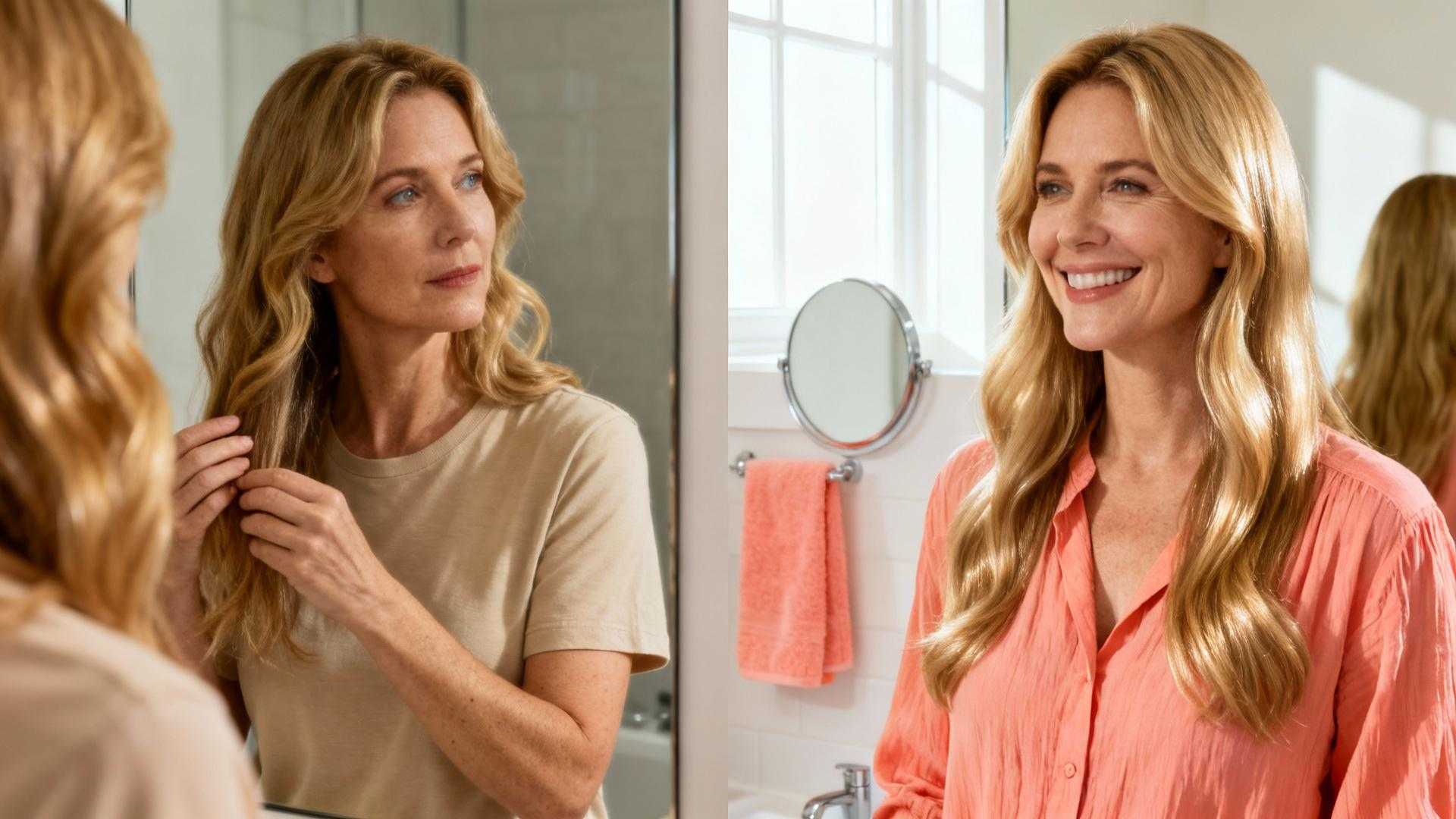Picture running your fingers through hair that catches light like liquid silk. That mirror-like shine isn’t luck or expensive genetics. It’s the result of understanding what happens at the microscopic level when your hair cuticles lie flat and smooth. Celebrity hairstylists achieve those red-carpet results by manipulating your hair’s physical structure using principles of light physics and biochemistry, not magic potions.
The physics of shine: why your hair’s cuticle layer is everything
Shine equals light reflection, which requires smooth, closed cuticle layers lying flat like perfectly aligned roof shingles. When cuticles lift due to damage, protein loss, or improper care, light scatters instead of reflects, creating that dull, lifeless appearance we all recognize.
Your hair cuticle comprises six to eight overlapping cells packed with proteins, lipids, and polysaccharides. The outermost component, called the epicuticle, is covered by a specialized lipidic layer known as the F-layer. This critical layer contains 18-methyleicosanoic acid bonded to keratin proteins, giving hair its natural hydrophobic character and dramatically reducing friction between strands.
Research published in Nature reveals that healthy hair has an average refractive index of 1.54 to 1.56 in the visible spectrum. Black hair exhibits the highest degree of linear polarization at approximately 0.45, explaining why darker hair often appears more lustrous. The smooth surface reflects polarized light more efficiently than damaged, rough cuticles.
The 5-week beauty cycle: how salon treatments rebuild reflective capacity
Professional treatments like Milbon’s approach work because they flood hair with concentrated moisture, lipids, and amino acids that penetrate deeply. This isn’t surface coating but structural repair that lasts 2 to 3 weeks because you’re replenishing lost compounds at the molecular level.
In-salon deep conditioning resets your baseline
The initial salon session costs $50 to $70 and uses heat or steam to force treatments past the cuticle barrier. Celebrity hairstylists’ morning routines that protect hair health emphasize this professional reset as foundational. Heat temporarily lifts cuticle scales, allowing molecular penetration to the cortex where structural damage occurs.
Weekly home boosters maintain hydration balance
Hair beyond 12 centimeters length loses its nutrient supply connection to the scalp, making external replenishment crucial. Weekly applications prevent gradual cuticle lifting that happens between salon visits. This cyclical approach outperforms one-time treatments because hair health degrades continuously. You’re matching care frequency to degradation rate.
The hidden saboteurs: what’s secretly stealing your shine
As Philip Berkovitz, celebrity hairstylist and founder of Philip B Botanicals, warns: “Silicones on the scalp, not a great idea. Heavier silicones make hair heavy, flat, and hard.” Heavy silicones create occlusive barriers that trap dirt and product buildup, weighing hair down and reflecting light unevenly.
The silicone paradox: when “shine” products cause dullness
Silicones block lipid moisture pathways, creating a paradox where shine-enhancing products ultimately dull hair by preventing natural oil distribution. The science behind why drugstore beauty products outperform luxury explains how understanding mechanisms beats marketing claims. Instead of coating hair, focus on cuticle integrity restoration.
The 70% dry rule: why application timing changes everything
Clayton Hawkins, celebrity hairstylist, reveals this counterintuitive technique: applying styling products on soaking-wet hair dilutes effectiveness and causes weigh-down. At 70% dry, the cuticle remains receptive but product concentration stays optimal. This timing hack optimizes performance without changing what you use, allowing volume plus shine without flat, greasy appearance.
Heat, blood flow, and scalp science: the supporting players
Scalp health directly impacts shine through circulation and follicle nourishment. Keka Heron, trichologist, notes: “A good scalp scrubber promotes blood circulation to the scalp, which can enhance hair growth and overall scalp health.” Weekly scalp massage for 5 minutes increases blood flow by approximately 25%.
Heat protection preserves cuticle integrity by preventing protein damage and permanent cuticle lifting. How natural kitchen ingredients transform your beauty routine offers DIY alternatives that protect without harsh chemicals. Microfiber towels reduce mechanical cuticle disruption during drying compared to traditional towels that rough up the surface.
Your Questions About This Is How to Get Your Shiniest Hair Ever, According to a Celebrity Hairstylist Answered
Can I achieve salon-level shine at home without the $70 treatments?
Yes, with strategic approach. DIY deep conditioning using $15 to $25 products can approach salon results if applied with heat and maintained weekly. Hair steamers cost $70 to $150 but enable professional-level penetration. The key difference is advanced delivery systems in salon formulations, but consistent home care plus annual professional resets works effectively.
Why do Japanese and Korean hair care methods emphasize shine so heavily?
Cultural hair care traditions in Asia prioritize multi-step routines addressing scalp health, hydration, and surface enhancement simultaneously. Why women over 50 are embracing natural beauty routines explores this holistic philosophy. Products like Milbon reflect this interconnected system approach rather than isolated problem-solving, explaining superior long-term results.
Is the $200 blow dryer really necessary for shine, or is it marketing?
Partially both. High-end dryers use ionic technology and controlled heat distribution that minimize cuticle lifting during drying, preserving natural shine. However, mid-range ionic dryers at $70 to $100 achieve similar results with proper technique. The premium pays for convenience and speed, not fundamentally superior outcomes.
Sunlight catches your hair mid-turn, each strand a liquid prism bouncing light like glass. That’s cuticle architecture working as designed, maintained through understanding molecular needs. Red carpet shine isn’t reserved for unlimited budgets. It’s biology, optimized.
